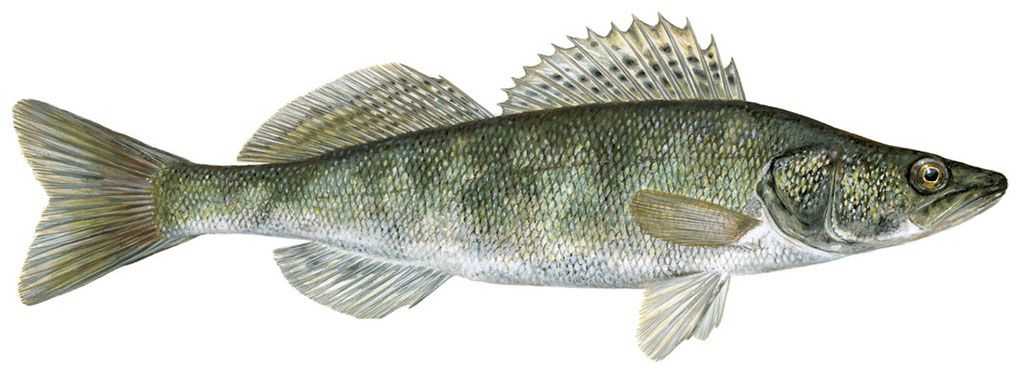Pike-Perch

Species Details
Sander Lucioperca
Percidae
Perciformes
Rivers, Lakes
1 - 11 lbs.
15" - 39"
Pike-Perch (Sander lucioperca) Fish Description
Pike-Perch or commonly known as a Zander are fish that are commonly used as bait for big catfishes like the Channel Catfish and the Black Bullhead or even for fishing Sea Bass. Despite being common bait, the Pike-Perch is considered the largest member of the Perch family. It has a torpedo-shaped body which helps them lower the friction of water as they swim, especially since they loiter more in rivers.
On the back and from a dorsal (top) view, it has a faded olive-green color which eventually merges with the cream white gradient on its belly. However, you’ll also notice that the back has jet black, vertical columns that stop right above a fading grey-black line that runs across its belly. The Pike-Perch’s dorsal fin is split into two sections: one containing 13-20 spines while the other part has 18-24 soft rays. Its anal fin is also composed of 2-3 rays accompanied with 10-14 softer ones. It also has a short but forked tailfin.
Aesthetically, you’ll also notice that the Pike-Perch has a bit of a snout and bulging eyes. Despite their slender body, the Pike-Perches have powerful jaws that can snap up their prey without any problems.
Pike-Perch Diet
A Pike-Perch has a strong jaw for a reason. Mainly, Pike-Perch prefers a carnivorous-piscine diet. They feast on small fish and have a preference for the small fish that school (probably to make the most out of their voracious appetite). However, some have reported that the Pike-Perch in the United Kingdom also like feeding on common roaches and Gudgeon.
Pike-Perch Size
Adult Pike-Perches can grow up to 39 inches (100 cm) though, on average they usually hit only 20 inches (50 cm). Usually, in lakes, Pike-Perches can be smaller due to overcrowding in comparison to some Pike-Perches that grow in rivers. However, someone reported catching a Pike-Perch that grew up to 11.48 kg (25.3 lbs) and 47 inches (120 cm).
Interesting Facts about the Pike-Perch
- Despite being carnivorous, the Pike-Perch and its cousins are commonly used as bait for other fish.
- In the United Kingdom, Pike-Perch are considered a non-native invasive species. Therefore, any angler who catches a Pike-Perch in the United Kingdom must kill the fish right away.
- People may be wary of eating Pike-Perch because it serves as a home for many parasites.
- Despite this, however, Pike-Perch are a common food staple in Europe and are often served because of their light but firm meat and little bones.
- Pike-Perches are cannibals. They eat smaller Pike-Perches (Zanders) if they’re hungry.
- Pike-Perches can only live up to 17 years.
- Pike-Perches look similar to the Walleye Perch.
- Walleyes however prefer clear, freshwater whereas Pike-Perches prefer murky, brackish water.
Pike-Perch – Fishing Techniques: How to Fish for a Pike-Perch
To get a Pike-Perch to go to you, you first have to go to its water body of choice: freshwater body but with murky waters. Some say even the canals where boats travel is the best place to fish for a Pike-Perch. Once you arrive there, you can set up your equipment.
Pike-Perch have a preference for dead bait. However, some can use live-bait but only if it’s not too alive. If it’s too alive, it may end up driving the Pike-Perch away. At the same time, depending on where you are fishing, there might be some rules about live bait just so you don’t introduce diseases into the water. Some people would even prefer if you caught the bait yourself there. Some possible baits for the Pike-Perch include common roaches or a Skimmer Bream. Mackerel is a good bait as well as it can withstand multiple casts. Small lures are also best to use to attract it to you for an easy time.
Pike-Perch Habitat and Distribution
Unlike their cousin, the Walleye, the Pike-Perch can withstand both brackish and freshwater bodies. However, they do have a preference for freshwater especially if it’s a large river or a lake that’s over nourished to the point of having a lot of algae blooms. But some people have reported seeing Pike-Perches living in coastal lakes and estuaries but quickly move up the river should it be time for them to spawn.
If in Europe, some people mentioned that they grow well in canals. They usually are found near boats where they feast on leftover trout and leftover salmon.







